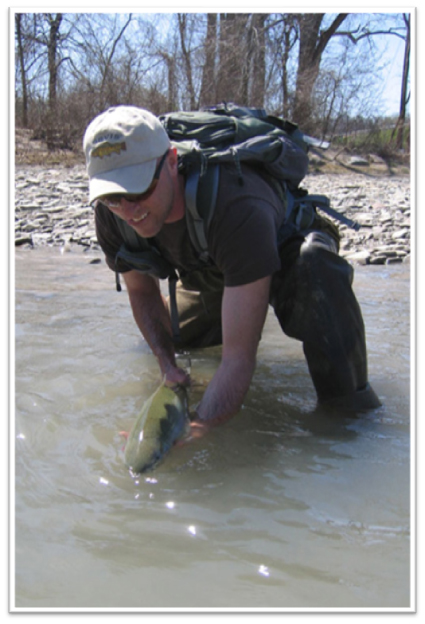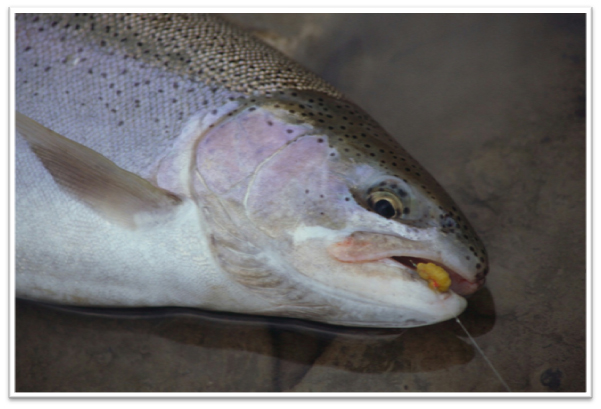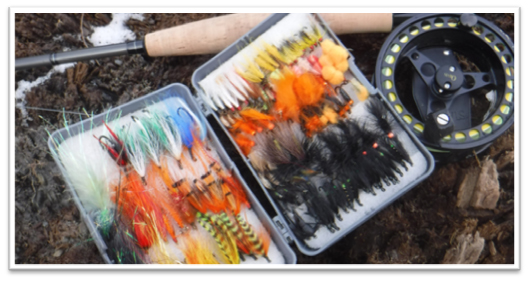Steelhead Season Approaches
ARTICLE BY INDREK KONGATS, SEPTEMBER 21, 2016

The fall steelhead season is about to start. With cooler temperatures in the forecast, leaves about to turn color and the recent heavy rains, the Cattaraugus Creek (Catt) is sending a strong signal to all the steelhead staging at its mouth that it is time to enter the river for their annual spawning run.
Everything is dependent on water levels, and this year the level is good, allowing the fish to run all the way to Scoby Dam in Springville, 30-plus miles up river from Lake Erie. Plans for lowering the dam by 25 feet and installing a fish ladder will allow steelhead to reach the upper portion of the Catt, adding another 40- plus miles of excellent steelhead water right in Springville’s backyard.
The Scoby Dam was originally built for hydro electric power production, but ceased to be used for such in 1998. Lowering the dam will allow the flushing out of the upper portion’s excessive sediment accumulation during severe rain run offs, thus improving steelhead spawning habitat and creating many deep holding pockets.
Ideal water conditions for steelhead come when the sediment has settled enough after heavy rains to go from a pea green color to a slightly clearer brownish tinge. The flow rate also has to drop to about 200-300 cubic feet per minute, allowing fish to navigate easily and safer wading for fisherman while accessing holding pools.
Steelhead are the ideal angling species in the Catt. Stocking of hatchery trout is costly, and because the river warms up to unacceptable temperatures in the summer months, trout can’t survive. Currently,in the main part of the creek, coarse fish like suckers and chubs inhabit the waters, offering little in the way of sportfishing.
Steelhead are really ocean-going rainbow trout transplanted into the world’s greatest freshwater ecosystem, the Great Lakes. Steelhead leave the creek or river that they are born in and spend the summer months in the larger body of water like an ocean or in our case, Lake Erie. When the time comes to spawn, they return to their birth place. 
The steelhead season is year-round on the Catt, with certain feeder streams like Spooner closed and posted until the steelhead have finished spawning. There is a significant production of wild steelhead from their spawning efforts, resulting in a self-sustaining population. With the upper river expansion, an estimated 240,000 wild steelhead fry are expected to reach their smolt stage before returning to the lake.
River access is another issue, and although there are public fishing stretches, one must cross privately-owned property that is closely-guarded and often with fees being charged, to access these public stretches. The first 20 miles of river are controlled by the Seneca Nation, and a separate fishing license is required to access their portion of the lower river.
Floating of the river without setting foot on the river bottom that is privately owned is a possible option but in order to have enough water to navigate the river, the fishing is usually at low optimal conditions.
With the proposed expansion of the upper sections of the Catt, access will improve dramatically and offer more public fishing possibilities. The impact of a well-planned and organized sport fishery will be tremendous for the local Springville economy; for retailers, gas stations, hotels and eateries. 
Anglers expect this annual migration and will head out to their favorite spots to test their luck. Various angling methods can catch fish,from fly rods to float rods to drift rods. All methods are acceptable and require their own set of skills and patience.
Unfortunately there are always unscrupulous individuals that snag fish or chase fish down stream into an awaiting landing net. It’s every anglers responsibility to report such behavior to the DEC. The sure signs of poaching are someone carrying a large landing net on a small stream or someone with a heavy rod and line outfit with oversized weighted hooks.
BLOG / NEXT ARTICLE / COMMENT

| 